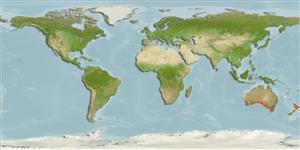>
Acropomatiformes (Oceanic basses) >
Hemerocoetidae (Indo-Pacific duckbills)
Etymology: Enigmapercis: Latin, aenigma = to speak allusively or obscurely + Greek, perke = perch (Ref. 45335).
More on author: Whitley.
Environment: milieu / climate zone / depth range / distribution range
Ecología
marino demersal; rango de profundidad 1 - 130 m (Ref. 9002). Subtropical
Distribución
Países | Áreas FAO | Ecosistemas | Ocurrencias, apariciones | Point map | Introducciones | Faunafri
Indo-Pacific: South Australia to central New South Wales, Australia, including Bass Strait.
Tamaño / Peso / Age
Maturity: Lm ? range ? - ? cm
Max length : 9.0 cm TL macho / no sexado; (Ref. 9002)
Short description
Morfología | Morfometría
Espinas dorsales (total): 0; Radios blandos dorsales (total): 29; Espinas anales 0; Radios blandos anales: 24. Pale in color, matching type of sand in which they bury (Ref. 9002). Anterior nostril with 2 projections (Ref 12932).
Usually buried in the upper parts of wave-formed sand in clear sand estuaries and coastal bays (Ref. 9002). Occurs in shallow waters and to at least 130 m (Ref. 9002).
Life cycle and mating behavior
Madurez | Reproducción | Puesta | Huevos | Fecundidad | Larva
Kuiter, R.H., 1993. Coastal fishes of south-eastern Australia. University of Hawaii Press. Honolulu, Hawaii. 437 p. (Ref. 9002)
IUCN Red List Status (Ref. 130435)
Threat to humans
Harmless
Human uses
Más información
PaísesÁreas FAOEcosistemasOcurrencias, aparicionesIntroduccionesStocksEcologíaDietacomponentes alimenticiosconsumo de alimentoRación
Nombres comunesSinónimosMetabolismoDespredadoresEcotoxicologíaReproducciónMadurezPuestaAgregación para la puestaFecundidadHuevosEgg development
Age/SizeCrecimientoLength-weightLength-lengthLength-frequenciesMorfometríaMorfologíaLarvaDinámica larvariaReclutamientoAbundanciaBRUVS
ReferenciasAcuiculturaPerfil de acuiculturaRazasGenéticaElectrophoresesheritabilidadEnfermedadesProcesamientoNutrientsMass conversion
ColaboradoresImágenesStamps, Coins Misc.SonidosCiguateraVelocidadTipo de nataciónSuperficie branquialOtolitosCerebrosVisión
Herramientas
Special reports
Download XML
Fuentes de Internet
Estimates based on models
Preferred temperature (Ref.
123201): 14.9 - 22.3, mean 17.5 °C (based on 332 cells).
Phylogenetic diversity index (Ref.
82804): PD
50 = 0.7500 [Uniqueness, from 0.5 = low to 2.0 = high].
Bayesian length-weight: a=0.00389 (0.00180 - 0.00842), b=3.12 (2.94 - 3.30), in cm total length, based on all LWR estimates for this body shape (Ref.
93245).
Nivel trófico (Ref.
69278): 3.3 ±0.5 se; based on size and trophs of closest relatives
Resiliencia (Ref.
120179): Alto, población duplicada en un tiempo mínimo inferior a 15 meses (Preliminary K or Fecundity.).
Fishing Vulnerability (Ref.
59153): Low vulnerability (10 of 100).
